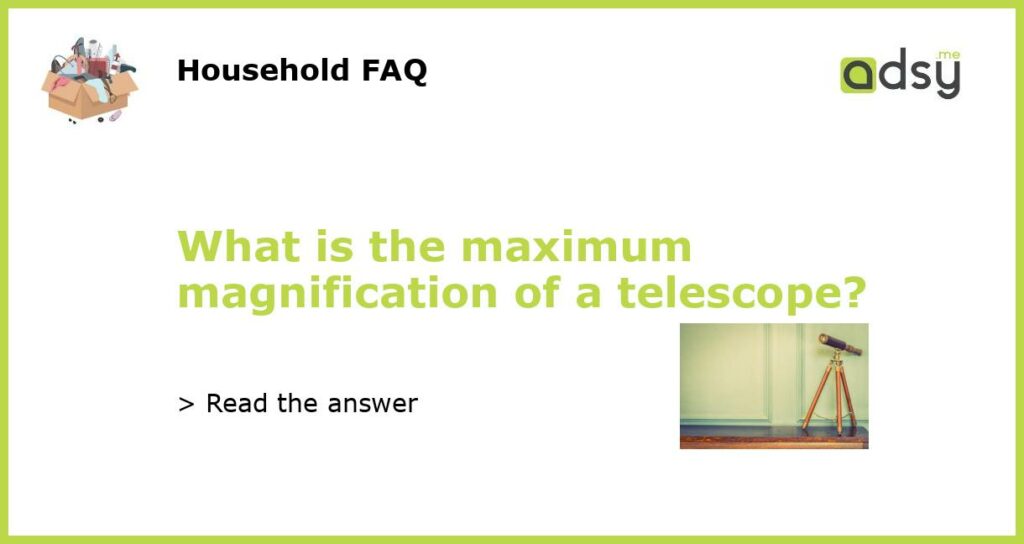Understanding Telescope Magnification
Telescope magnification refers to the amount by which the telescope can enlarge an object when compared to the naked eye. It is one of the key factors that determine how much detail can be seen through a telescope. When shopping for a telescope, it is important to understand the maximum magnification it can achieve and how it may impact your viewing experience.
Factors That Affect Maximum Magnification
The maximum magnification of a telescope is influenced by several factors:
- Aperture: The size of the telescope’s primary objective lens or mirror determines its light-gathering ability. A larger aperture allows for a higher maximum magnification.
- Optical Quality: The quality of the telescope’s optics, including the lenses and mirrors, can affect its ability to handle high magnifications. Higher quality optics tend to provide better images at higher magnifications.
- Focal Length: The focal length of a telescope determines the eyepiece magnification that can be achieved. Longer focal lengths typically allow for higher magnifications.
- Atmospheric Conditions: The stability of the atmosphere can impact the clarity of the image at high magnifications. On nights with poor atmospheric conditions, the maximum usable magnification may be lower.
Theoretical Maximum Magnification
In theory, the maximum magnification of a telescope is calculated by dividing the telescope’s objective lens or mirror diameter by 7 or the telescope’s aperture in inches by 50. This equation provides a general guideline for determining the maximum useful magnification, although it is not an absolute rule.
For example, if a telescope has an aperture of 100mm (approximately 4 inches), the maximum useful magnification can be estimated to be around 28x (100mm divided by 7), or around 50x (4 inches divided by 50).
Practical Limitations of High Magnification
While it is possible to achieve high magnifications with a telescope, there are practical limitations that can impact the quality of the view:
- Image Quality: As the magnification increases, the image quality may start to degrade due to factors such as lens aberrations or imperfections in the telescope’s optics. This can result in a loss of detail and clarity.
- Faintness of the Object: Higher magnifications can often make faint objects appear even fainter. This is because the light is spread out over a larger area, reducing the brightness of the image.
- Field of View: High magnifications also decrease the field of view, meaning that you will see a smaller portion of the sky at once. This can make it more challenging to locate objects and track them as they move across the night sky.
- Atmospheric Conditions: As mentioned earlier, atmospheric conditions can significantly impact high magnification views. Turbulence in the atmosphere can cause the image to appear blurred or distorted, making it difficult to focus and observe fine details.
Magnification and Telescope Users
The ideal magnification for a telescope varies depending on the user’s preferences and the type of observing they want to do:
- Beginners: Beginners may find lower magnifications more suitable as they allow for a wider field of view and easier object location. A magnification range of 25x to 50x is often recommended for beginners.
- Amateur Astronomers: Amateur astronomers who want to observe the moon, planets, and other bright objects may prefer higher magnifications in the range of 100x to 200x.
- Deep Sky Observers: Those interested in observing faint galaxies, nebulae, and star clusters may benefit from lower magnifications (50x to 100x) to maintain a wider field of view and maximize brightness.
- Astrophotographers: Astrophotographers often use lower magnifications to capture wide-field images that encompass large areas of the sky. This allows for longer exposures and capturing more detail within the frame.
In summary, the maximum magnification of a telescope is influenced by factors such as aperture, optical quality, focal length, and atmospheric conditions. The theoretical maximum magnification can be estimated using a simple formula, but the actual maximum useful magnification may vary. Practical limitations, such as image quality, faintness of the object, field of view, and atmospheric conditions, should be considered when choosing a magnification for observing or astrophotography.






